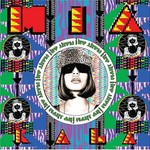Kala
Studio Album by M.I.A. released in 2007Bamboo Banga | |
BirdFlu | |
Boyz | |
Jimmy | |
Hussel (feat. Afrikan Boy) | |
Mango Pickle Down River (feat. Wilcannia Mob) | |
20 Dollar | |
World Town | |
The Turn | |
XR2 | |
Paper Planes | |
Come Around (feat. Timbaland) |
Kala review
How a sequencing machine can change somebody's life
Music career of Mathangi Arulpragasam who is better known as M.I.A. began quite unexpectedly. Initially, Mathangi was involved in visual arts and was just a mere audio lover. Somewhere in the beginning of 2000 she received a commission from Elastica's Justine Frischmann to provide the artwork and cover image for the band's upcoming album. After this successful cooperation Mathangi followed Elastica on tour around USA to document the events on video to use them for the band's music video. During this tour Mathangi got acquainted with such a thing as sequencing machine and after coming back to London gradually learned using it. Consequently she recorded her first demo comprised of six songs, which attracted attention of a small independent label Showbiz Records. As a result, 500 copies of her first single Galang were released in 2003. The single became popular and made an immediate impact with DJs. M.I.A's popularity began spreading via internet and by the time when she released her first album Arular her name became known on both coasts of Atlantics. Her unusual style, which held electro funk, dancehall, hip-hop, drum and bass and world music brought her enviable fame in the electronic underground and public met her debut record with raving enthusiasm. The public excitement was extraordinary, critics praised her and fans were buying up her album, which managed to take part in Mercury Music Prize Awards and brought M.I.A. worldwide fame even despite its anti mainstream character.
Kala was recorded on the journey across the globe
M.I.A. began working at her second album Kala in 2006. The album was recorded on the journey while M.I.A. was traveling across India, Trinidad, Jamaica, Japan and Australia. Of course, all this events influenced the way new album sounds: there are lots of thing like village choirs, radio buzz, Nigerian MC or Hip Hop band composed of Aborigines. But all these things are just an addition to the incredible sound of Kala. The album simply dissolves with digital energy. Swarm of samples and armada of merciless beats are followed by flows of heavy synthesized sounds. M.I.A.'s voice can be soft but it can be eerie and aggressive too, choral singing, rapping with heavy accent – all these tings get along somehow inside one album. The behavior of tracks is unpredictable and sometimes twists and turns of sonic vortex throw out something very unexpected. Nevertheless, despite this restless and experimental character the album was definitely influenced by the mainstream sound. In comparison with the previous record the production corresponds to the commercial standards more evidently thus opening absolutely new horizons before M.I.A.
Kala is able to set the fashion
The most interesting tracks of the album are those where M.I.A. gives preference to singing. Perhaps she is not the best vocalist in the world but her voice agrees to the bustling mood of the album quite well. Track called Paper Planes turned out to be a very good one in this sense as it softens record's intensive sonic character. However the album's trademarks are those songs where M.I.A. raps. Listen to BirdFlu or Boyz, here lies the core of the album with its nervous beat and omnipresent sinning, speaking or screaming voices. The most unexpected track here is Jimmy – a remix cover version of a song from Indian movie Disco Dancer called Jimmie Jimmie Aaja. In comparison with any other track of Kala it sounds very straightforward and accessible. Another album's highlights are Mango Pickle Down River (With The Wilcannia Mob) и 20 Dollar. Here M.I.A. continues blending electronic, hip-hop and ethnic music. Overall, Kala is a pretty ambiguous album. It is not just a mixture of genres in M.I.A.'s interpretation it is something much bigger. This is a musical experiment, which is able to set the fashion and get along with the masses. Kala is one of those rare albums that can achieve commercial success even despite its experimental character.

